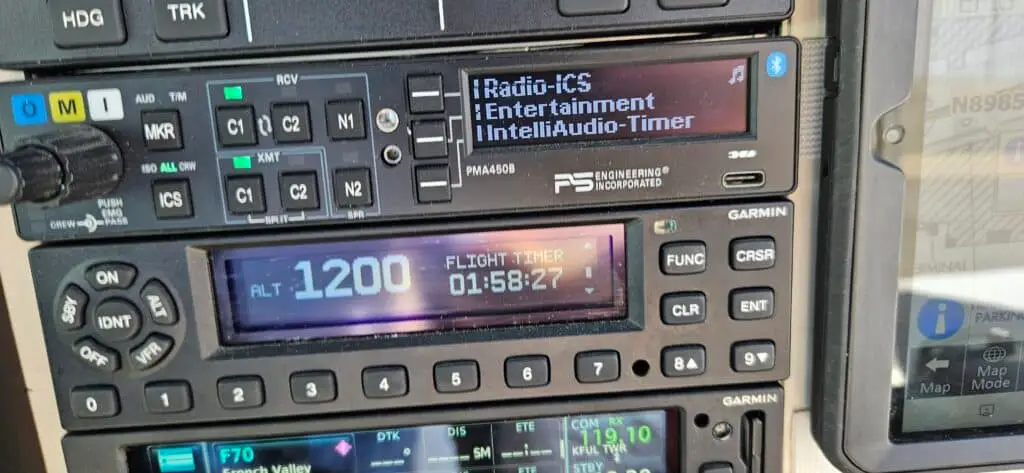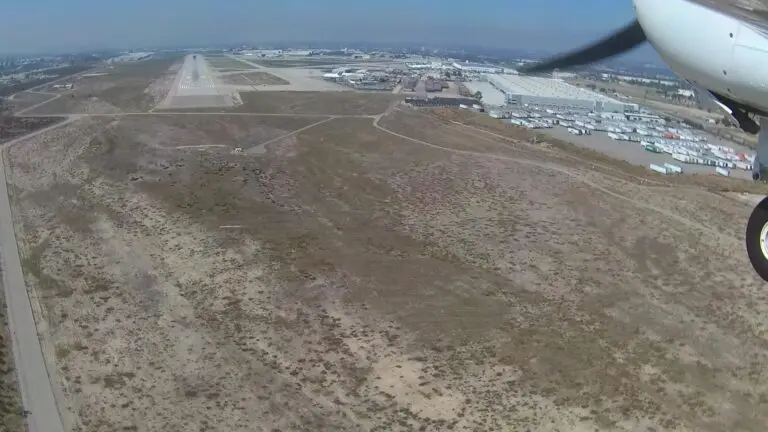**NOTE** There is video, but it is still in post-production. And as I am the amateur producer it is taking a minute to go through eight hours (4 cameras and 2 hours each) of footage and to compile the video. Once it is published I will update this post and include it in a future newsletter. If you want to be notified about the video when it is published please subscribe to my YouTube channel.
We do a lot of long distance cross country flights. Nearly 800 hours of my 930+ hours fall into the “Cross Country” category which is any flight where the direct distance between the two airports is over 50nm. Most of those hours fall into the 300+nm distance.
I also make quite a few local flights, flightseeing up and down the coast, or just a short hop somewhere for breakfast or lunch. So, I as I was thinking of something different to do, I thought, “What if I tried to hit all the Inland Empire airports in one flight.”
Then I counted them up, and not including March Air Reserve Base there are 12 of them!
- Corona (KAJO)
- Perris (L65)
- French Valley (F70)
- Hemet-Ryan (KHMT)
- Redlands (KREI)
- San Bernardino (KSBD
- Flabob (KRIR)
- Riverside (KRAL)
- Chino (KCNO)
- Ontario (KONT)
- Cable (KCCB)
- Brackett (KPOC)
I did not know there were that many… but, I mapped them all out and decided it was poissible.
There were a few challenges to completing it in one flight. I wanted to do it in a reasonable time which meant touch and go’s at most if not all of the airports. That was why I left out March ARB, which you can land at, but must taxi to the FBO and shut down. It also meant that I needed all VFR conditions because waiting for IFR clearances at all of them would take forever.
Finally, the logistics of 13 landings in a row, with some of the airports less than 5 miles apart, including Flabob and Riverside less than 3 miles apart, meant I needed a good gameplan and must stay sometimes thinking a couple airports ahead.
I scrapped the flight the week before because the weather just wasn’t going to work, but on this Saturday the forecast was promising. In preparation the night before I filed VFR flight plans to all of the airports so I would be able to get briefings and know of any NOTAMs. To cut down on the number of flight plans needed, I filed the first leg and then put the next two stops in as alternates. Then I filed from my 4th landing to the 5th, again adding in the next two stops as alternates one and two.
The next step was to write down on my kneeboard every leg of the trip with space in between to write down the weather. Once I got to Redlands it was going to be rapid fire between airports and I wanted to pick up the weather for multiple stops on the longer legs. I added in the altitude I wanted to fly the leg along with the runways, field elevation, and frequencies for weather, tower, and ground where applicable.
All of that information is in my panel GPS, and the flight plan would be programmed in, but looking at the kneeboard would be quicker sometimes.
Saturday morning dawned with clear, yet hazy skies. I sat down at my computer and pulled all my briefings, learning that at Ontario runway 08L/26R was closed and hoping that they could fit me in. The controllers at ONT have always been very accommodating going back to when we did multiple touch and go’s along with a simulated engine out landing opposite traffic during my primary training.
With that done I headed to the airport pre-flighted the plane, set up cameras, and then called up the fuel truck to top me off.
My plan was to just take it one landing at a time, and then move onto the next, not getting overwhelmed by the amount of work remaining. It is a similar strategy to chopping up a long cross country into the individual legs of the trip.
The shortest runway of the trip would be Flabob at 3,190′ and the only question mark in the touch and go plan. The first stop was Corona at 3,200′ which I had done touch and go’s at a long time ago. I planned to do one there and based on how I felt with runway remaining I would either do one later in the flight at Flabob or treat it as a full stop taxi back. The key was going to be watching my speed and not floating. The other piece of the plan was to land with takeoff flaps so I wouldn’t need to reconfigure flaps on the roll.
I departed Fullerton, climbed to 2,500′ and after being given a frequency change by the tower I picked up the weather at Corona. It favored runway 25 so I circled that on my kneeboard to remember which runway I was using when making my radio calls. I figured that having the extra reminder would help me keep my calls straight as the flight progressed.
There was only one other plane in the Corona area when I entered the pattern. I was careful to watch my speed and touched down on the second stripe, about 300′ from the arrival end of the runway. As soon as I had the nose wheel down and made sure I was tracking straight down the center I eased the throttle back in and the plane practically jumped off the runway. Airborne with more than 1,500′ of runway remaining I said, “Oh, yeah, we can totally do Flabob.”
Next up was Perris, the only airport on the trip I hadn’t landed at. There is no weather reporting so I picked up the weather from March ARB, seven miles to the north. March was reporting light winds from the northwest so I planned to use runway 33. The jump plane had landed on 15 and then departed on 33 so I asked over the CTAF what they were using. Someone came over the CTAF and asked, “Mooney, are you familiar with Perris?”
“I know you have jumpers and not to overfly the airport,” I replied.
He came back saying there was a light wind from the south east. I thanked him and said I was still going to use 33 for a touch and go. With the 5,100′ of runway available I would have plenty of runway to work with. I was a little faster than at Corona and with the slight quartering tailwind I touched down 900′ down the runway but was easily off again with almost 3,000′ of runway remaining.
Two down, ten to go.
French Valley was the first busy airport with a number of planes in the pattern to go along with the arrivals and departures. With the traffic on my tablet and the calls on the radio I created a picture in my mind where everyone was and made my traffic calls inbound. I spotted the guy on downwind as I was getting ready to cross over midfield and came in behind him.
After the touch and go at French Valley there was 11nm to Hemet followed by 22 to Redlands, after which it was going to get busy quick. Following the buzz of activity at French Valley Hemet and Redlands were sleepy. There was a Pilatus departing Hemet as I entered the downwind and there was no traffic at Redlands. I think the 4-5 miles of visibility caused by the haze was keeping some folks on the ground.
It would have been helpful to hear someone in the pattern at Redlands as that would have eliminated my error on the trip. Standard pattern is left traffic, and I had just done left traffic at Corona, Perris, French Valley, and Hemet. I had even put in the extended centerline for runway 26 at Redlands which shows whether it is right or left traffic, but did not notice the little barb showing right traffic.
I entered a left downwind (wrong) and then turned a left base (wrong). As I finished my radio call and turned base someone on the ground called up, “There’s nobody in the pattern, but it is right traffic.”
“Thanks, sorry,” I called back.
I had been monitoring the CTAF at Redlands for the past ten minutes and started making my calls 10 miles out. Had there been traffic I would have heard them announcing right traffic which would have jogged my brain.
Now everything was going to start happening fast. With four miles between Redlands and San Bernardino I had picked up the weather before getting to Redlands. Redlands also doesn’t have its own weather reporting and uses San Bernardino’s. KSBD was the first towered field on the route, so as soon as I turned crosswind I called up KSBD tower.
Me: “San Bernardino tower, Mooney one-zero-one-five-echo, just departed Redlands, we have zulu, requesting a touch and go.”
Tower: “Mooney one-zero-one-five-echo, San Bernardino tower, altimeter is three-zero-zero-four, and what’s your request after the touch and go?”
Me: “Departure to the southwest to Riverside.”
Tower: “Mooney one-five-echo, report a two mile left base runway two-four.”
We were already on a three mile base.
Me: “We are on a three mile base runway two-four.”
Tower: “Mooney one-five-echo, roger, in sight, enter a left base runway two-four, winds two-seven-zero at six, touch and go and on the go your southwest departure is approved.”
Me: “Two-four cleared touch and go and on the go southwest departure approved, one-five-echo.”
By the time we had finished the calls I was rolling out on final with the 10,000′ long and 200′ wide runway of Ontario laid out in front.
Ontario was followed by Flaboband then into another buzz of activity at Riverside. I have gone from Flabob to Riverside before, and with only 2.8nm between them you have to be on your radio game. As soon as you are turning crosswind off runway 24 you are switching frequencies and calling up Riverside tower.
I had picked up the weather at Riverside before landing at Flabob, but when I changed frequencies I couldn’t get a word in, it was rapid fire between the tower and multiple airplanes. I quickly continued my turn onto the downwind leg to depart eastbound and keep from busting Riverside’s airspace.
I was east of Riverside’s airspace and southbound, still waiting for a chance to get in a radio call when the tower was pointing me out to other planes.
“Traffic southbound at two thousand one hundred, altitude and type unverified.”
“Hi, that’s me,” I was saying in my plane to nobody.
Finally having worked my way all the way to the south of KRAL I had a chance to call up and request the touch and go. The tower instructed me to enter a left base for runway 27 following a Cessna. I turned base to final and he cleared me to land.
Tower: “November one-zero-one-five-echo, traffic departing prior to your arrival, runway two-seven, cleared to land.”
What followed is an example of what not to do on the radios. You should give ATC everything you are requesting. It greatly reduces the amount of transmissions, you’ll see what I’m talking about.
Me: “Two-seven cleared to land, requesting a touch and go if possible.”
Tower: “Bonanza one-sierra-echo (second time he got that one wrong) runway two-seven cleared touch and go, then left closed traffic, Cessna departing prior to your arrival.”
Me: “Was that cleared touch and go one-zero-one-five-echo?” (I wanted to make sure I heard my number.)
Tower: “November one-zero-one-five-echo cleared touch and go then left closed traffic.”
I really didn’t want left closed traffic, I wanted to leave the pattern, but I cringed inside when I made the next call. I also didn’t want to ask for a departure to Chino at that point, I just wanted to get out of his airspace and regroup before the rapid fire Chino-Ontario-Cable-Brackett legs.
Me: “Cleared touch and go and left closed traffic, requesting departure to the southwest, not closed traffic.”
“He’s gonna hate me,” I said to myself.
Tower: “November one-five-echo that southbound is approved.”
Me: “Roger, thank you one-five-echo.”
That was the last hiccup in the flight. I headed out to the southwest and picked up Chino, Ontario, and Brackett’s weather before heading inbound to Chino.
I requested the touch and go at Chino and a departure to Ontario if possible. The KCNO tower cleared me and told me they would have a squawk code for me on the go. Ontario is a Charlie class airport and they want you on a specific squawk before entering the airspace.
Ontario, despite only having one runway cleared me to land before I was even on the downwind. I checked the weather again at Brackett to make sure they hadn’t updated it. There was a Delta 737 holding short as I crossed the threshold of 26L, and then as we were climbing out he was cleared to depart behind me so I made an early turn toward Cable.
A quick left crosswind turn off Cable for the noise abatement procedures had me southbound and calling up the Brackett tower who cleared me straight in runway 26L for the option. As I lined up on final at Brackett that first touch and go at Corona felt like a lifetime ago. I couldn’t believe it was the same flight.
Ten minutes and fifty seconds after wheels up at Brackett I was back on the ground at Fullerton. The timer on the transponder showed a total of one hour, fifty-eight minutes, and twenty-seven seconds.

My kneeboard notes were all scribbled and slightly legible when done.
As I was taxiing back to the hangar, I finally relaxed and started talking to myself.
“Woohoo! Yes! Ah, dude, I did it, oh my goodness, that was a lot of work and a lot of fun.”
Would I do it again? Definately, but I think I would bring someone along for the journey. However, before I do that again, I have something else in mind. Stay tuned.





